How to choose a pool pump: a comparative review of different types of units
Do you want to equip your own pool, creating a paradise out of it? So, are you looking for a pump for your pool, but the range is so large that it’s difficult to settle on a specific model? Agree, it’s a good idea to get a unit that is inexpensive, but can still satisfy your needs. What is better: providing clean and warm water in the pool or turning your pond into a jacuzzi?
We will help you choose the best option - the article discusses the main types of pumps used for swimming pools, their characteristics and capabilities. There are also reviews of popular models with sand filters for heating water and for creating a counterflow.
To make it easier for you to choose your pump option, we have selected videos and photos that clearly demonstrate the capabilities of the units reviewed. Many of the models are capable of solving various problems, helping to turn the pool into a wonderfully equipped artificial pond for a pleasant country holiday.
The content of the article:
Why is there a pump in the pool?
A pump is a device for pumping liquid. The number of pumping devices in the pool depends on the complexity of the entire reservoir system and the volume of water.
The number is also influenced by the presence of special areas: spa, hydromassage, fountains, sports, and attraction areas.
Several types of pumps are involved in maintaining and ensuring the normal operation of the pool:
- Pump for pumping water. Required for filling an artificial reservoir, for emptying the container in case of repairs, sanitary care, or preservation for the winter.
- Circulation pump. Ensuring the movement of water to the cleaning and heating units and back.
- Heat pump. It is used in the case of an alternative system for obtaining thermal energy instead of the traditional heating option.
- Counterflow pump. It is used in organizing hydromassages, water attractions, waterfalls and similar special effects.
All these pumps have their own specifics. The purpose of the following review is to show the variety and principles of choosing pumping equipment for the water world of swimming pools.
Types of pumping equipment for pools
Pumps, traditionally used to service swimming pools without specific functions, can be divided according to the principle of operation into centrifugal and vortex.
Type #1 - centrifugal and vortex units
In centrifugal pumps, the impeller is a disk with curved blades. Moreover, the blades are bent in the opposite direction of rotation. The pump body has a snail shape.
When the impeller rotates quickly, water is carried away by the blades and pressed against the walls.
As a result, two things happen at once:
- A vacuum is created in the center, like in a funnel.
- Water moving along the increasing radius of the casing snail picks up speed and is pushed out.
Centrifugal pumps are characterized by: low pressure, low noise, large volume of pumped water.
For the pump to operate, it is necessary to fill the inlet pipe and the impeller housing with water, since such a system will not push air through.
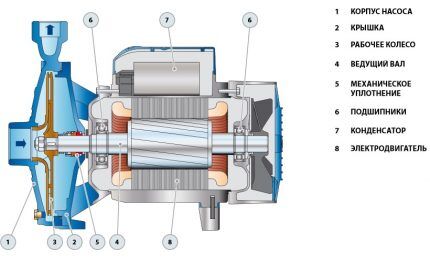
Vortex pumps have a special impeller design called an impeller. The vortex pump housing fits the impeller quite tightly in diameter, but has a gap on the sides.
When the impeller moves, the water flow swirls in the form of vortices on the blades, hence the name.
Due to the small gap, the vortex pump is able to operate on a mixture of air and water. Vortex pumps are able to start suction with a small amount of water or without it at all, and therefore do not require mandatory filling of the pipe before starting work.
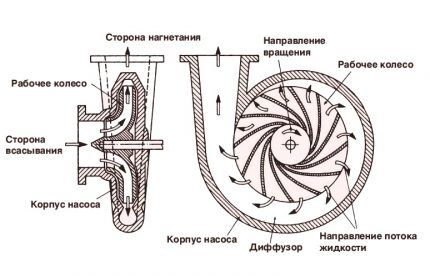
Vortex pumps are characterized by: high outlet pressure, increased operating noise, and a small volume of pumped water.
Both types of pumps without additional devices cannot create a vacuum of more than 1 atmosphere, therefore they are limited to a pressure of 10 m, which is quite enough for servicing swimming pools.
Type #2 - self-priming pumps
Self-priming pumps are the most common because they can be installed above or below the water level. This is especially true for frame and inflatable pools, when it is not possible to place equipment under the pool.
The self-priming pump is capable of drawing water from a height of three meters.However, it should be borne in mind that raising water requires significant energy, so the pump should be installed as low as possible.
When choosing a pump, you must consider:
- Throughput of filter elements. It must match the pump performance.
- Diameter of suction and discharge pipes.
- The volume of pumped water complies with sanitary standards.
- Possibility of long-term work.
- Noise level.
- Material of manufacture.
When choosing self-priming pump It is necessary to pay attention to the ease of maintenance of the unit. The presence of an inspection window helps determine whether the filter is full.
The casings of self-priming pumps are made of reinforced plastic, the shaft and fasteners are made of stainless steel.
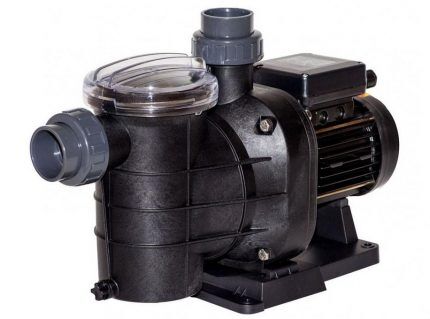
Type #3 - pump with filter element
Pumps with a filter element are most often used for ready-made pools: frame or inflatable. Such devices are supplied by the manufacturer with an appropriate filter.
The simplest water treatment systems can only use one pump of this type.
There are several types of filter elements:
- sand pumps;
- paper cartridges.
Pumps with paper cartridges It is advisable to use for small-volume pools. Paper filters effectively purify water, but cannot provide a large volume of water.
In addition, they have to be replaced quite often, which has a negative impact on the cost of maintenance.
Pumps with sand filter or sand pumps, are more efficient and designed for large volumes of water.Water is passed through quartz sand and all the dirt, even the smallest particles settle in the sand.
To clean the sand filter, water is passed in the opposite direction and drained into the sewer.
Instead of quartz sand, other adsorbents can be used: glass sand, gravel, anthracite, carbon. Carbon based filters are the most effective.
When choosing a filter adsorbent, pay attention to the operating time. For example, quartz sand needs to be changed once every three years, and glass sand - once every five years.
Additionally, ozonizers are installed on sand pumps. Ozonators kill microorganisms and oxidize small particles of dirt, causing them to disintegrate.
The disadvantage of pumps with a filter element is that two devices, a filter and a pump, are mounted in one housing. If one of the devices becomes obsolete, you will have to buy both.

Type #4 - circulation units
The circulation pump is one of the main units necessary for the normal functioning of the pool.
The simplest artificial reservoir can be managed with one pump of this type. It is responsible for creating a constant flow of liquid through the filter elements.
According to the sanitary standard, the circulation pump must have such a capacity as to pump the entire volume of pool water at least 4 times per day.
As for inflatable or frame pools with one pump, its productivity should be about ¼ of the pool volume per hour.
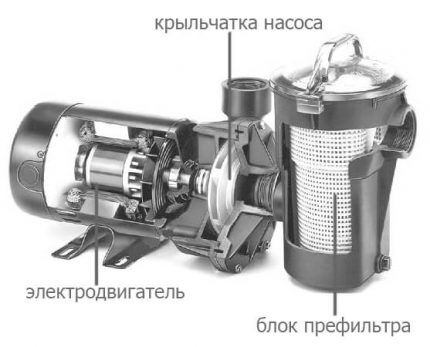
The circulation device used in the construction of a swimming pool differs from other types of pumps in two ways:
- Availability of filter element. It prevents large debris from jamming the pump impeller.
- Case material. Resistance of the body materials and technical filling of the pump to corrosion and destructive oxidation occurring due to the use of disinfectant chemicals.
The circulation pump should be selected according to pressure criteria depending on the degree of complexity of the pool being equipped.
A low-pressure machine is sufficient if you only plan to move water into the tank to distribute antiseptics and direct flows to the filters. Those wishing to organize their own water park should be interested in models with high pressure values.
Type #5 - submersible models for pumping water
To pump water out of the pool, you can use a self-priming circulation pump. It should be borne in mind that self-priming pumps for inflatable and frame pools are not designed for long-term operation.
Manufacturers do not recommend using self-priming pumps to drain water more than once a week.
Specialized pumps for pumping water are made submersible. They have wide intake windows and are capable of pumping out contaminated water with particles up to 5 cm.
The pumps have a built-in automatic shutdown system when there is no water. Capable of pumping out water up to 1 cm or less.
Household drainage pumps for universal use, they usually have a float that turns off the pump when the water level is 5-10 cm below the pump height. They cannot completely pump out the water.
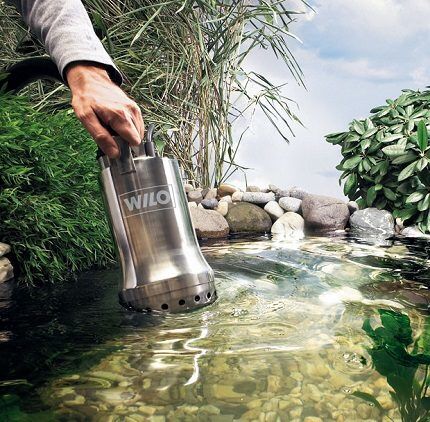
Type #6 - modifications of pumps without prefilters
Pumps without prefilters are used for large and stationary swimming pools. Characterized by great power and performance.
Such pumps are used for:
- circulation;
- hydromassage;
- waterfall;
- fountain;
- SPA.
Pumps without a prefilter are used as an addition to an existing system. As an additional circulation pump or to create special areas in the pool.
Popular models with sand filter
We offer a rating of the most popular modifications of pumps, which are preferred by owners of private pools around the world.
Model #1 - Intex
The international Chinese corporation Intex is the largest manufacturer of inflatable and frame pools. Affordable price and high quality, durability are well-deserved characteristics of Intex brand products.
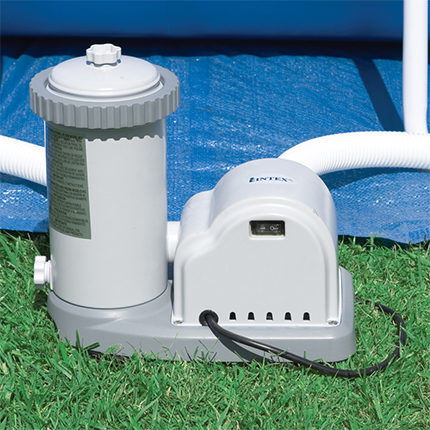
Suitable for small swimming pools.
Main characteristics:
- mains voltage - 220V;
- flow rate - 5600 l/h;
- Case material: plastic.
The fully finished pump is mainly used for inflatable and frame pools. Has threaded connection of pipes. Used for short-term, seasonal cleaning and circulation, after which it is put away for storage.

One of the most common options for home use.
Main characteristics:
- mains voltage - 220V;
- flow rate - 8000 l/h;
- Case material: plastic.
The pump is equipped with a timer for automatic on/off. The filter can use quartz or glass sand. The connection of the pipes is threaded.

Quite a serious unit for an average pool.
Main characteristics:
- mains voltage - 220V;
- flow rate - 10000 l/h;
- Case material: plastic.
Produces 11 g/h of chlorine, effectively fights microorganisms, mucus, and algae. The main filter element is quartz or glass sand.
Model #2 – Kripsol
The next manufacturer of swimming pool equipment is the Spanish Kripsol. The company's products are widely known throughout the world and are available in a wide range.
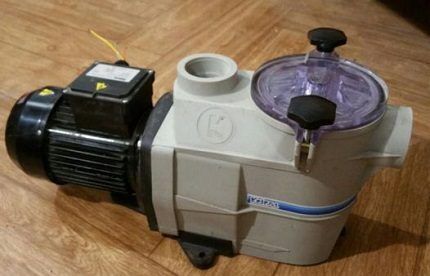
Main technical characteristics:
- mains voltage - 220V;
- flow rate - 14500 l/h;
- body material - polypropylene.
The sand filter holds 125 kg of sand. The unit is equipped with a six-position valve. There is a pressure gauge.
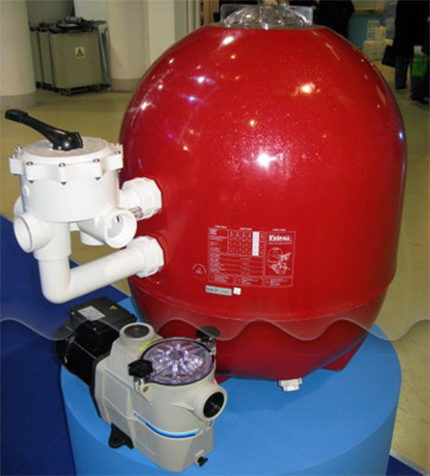
A powerful and durable filter; high-quality materials are used in the manufacture of the pump.
Main characteristics:
- mains voltage - 380V;
- flow rate - 30,000 l/h;
- body material: fiberglass reinforced polyester.
The filtration unit is intended for private and small public swimming pools. The unit is equipped with a multi-port valve for cleaning and maintenance.
Model #3 - Emaux
The Hong Kong company Emaux is a large manufacturer of swimming pools and equipment for them; the company has representative offices in 70 countries around the world. List of manufactured products: from swimming pools to attractions.
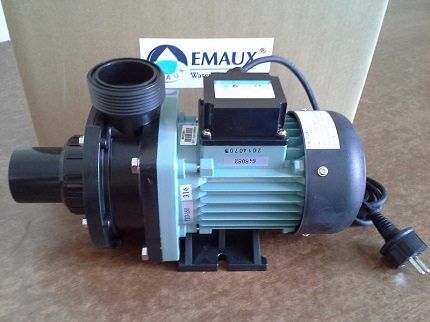
Main characteristics:
- mains voltage - 220V;
- flow rate - 5600 l/h;
- Case material: plastic.
The housing material is UV and moisture resistant. The unit is equipped with two air release valves.
A device with a stable base and low weight, suitable for small inflatable pools.
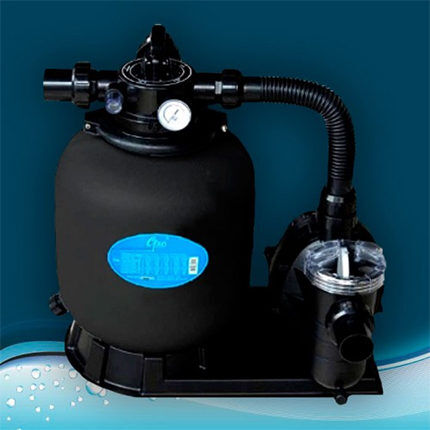
A sand pump can purify water until it is clear, but microorganisms will remain.
Main characteristics:
- mains voltage - 220V;
- flow rate - 13000 l/h;
- body material: polyethylene.
The volume of loaded sand is 145 kg. The delivery set includes a pressure gauge and a four-position valve. Cleaning fineness – 20-30 microns.
Model #4 - Behncke
Behncke is a German manufacturer of water-related equipment. It is one of the highest quality suppliers on the Russian market.
The family business was founded in 1946 and is currently managed by the third generation of owners.
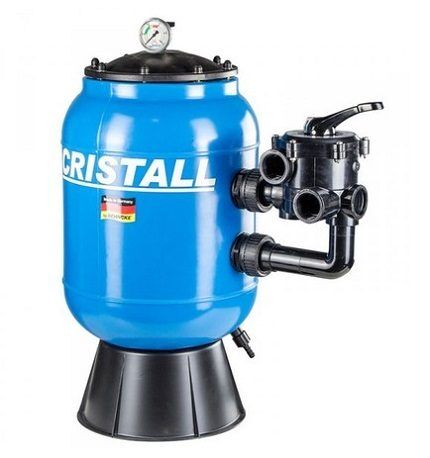
Main characteristics:
- mains voltage - 380V;
- flow rate - 32000 l/h;
- body material - polypropylene.
The filter unit holds 375 kg of sand. A six-position valve controls various operating modes. Suitable for pools with a volume of up to 160 m3. When choosing filter units it is necessary to focus on the cleaning method.
Cartridge and cassette filters are suitable for small volumes of inflatable and frame pools. Easy to maintain and do not require sewerage.
Sand filters are suitable for medium and large volumes, up to public swimming pools. They are distinguished by their impressive mass and often require a three-phase connection.
Heat pumps for swimming pools
In most of our country, summer is coming to an end very quickly. During the night or in cloudy weather, the water in the pool cools down. Traditional heaters are expensive to heat a pool.
Working principle of a heat pump
Principle of operation heat pump can be clearly seen in the example of a household refrigerator. The heat pump includes: heat exchanger, compressor, evaporator.
The heat pump system circulates freon, a gas that can turn into a liquid state at room temperatures. When the phase state of freon transitions, heat is taken from the environment and then the circulating water is heated in the heat exchanger.
In short, the refrigerator is the opposite: the environment is cooled, the water is heated.
Based on their interaction with the environment, there are three types of heat pumps: ground-to-water, water-to-water, air-to-water.
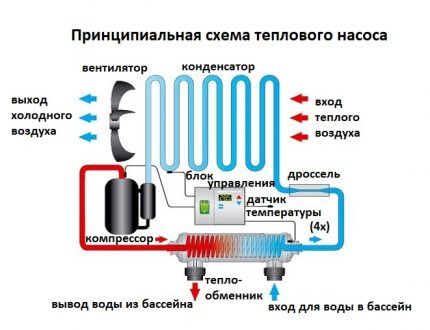
Criteria for selecting a heat pump
Each type of pump has its own circuit installation rules. Ground-water pumps require the installation of horizontal or vertical pipes.
In any case, pipes must be laid at a depth of at least 2-3 meters - to the freezing depth. Trees with a strong root system cannot be planted from above.
Water-to-water pumps use the energy of reservoirs. Such pumps are a profitable option because they do not require excavation of the previous type of pumps.
In these systems, installation to a freezing depth of 2-3 meters is also required. The distance from the reservoir to the pool should not be more than 100 meters.
Air-to-water systems do not require complex piping and are easy to install. However, air-water pumps less effective, since they extract the thermal energy of the air and depend on its temperature in a specific time period.
When choosing an air-to-water heat pump, you need to consider:
- pump installation location (sun or shade);
- average air temperature;
- pool volume;
- type of pool (outdoor or indoor).
Regardless of the chosen heat pump system, on average, approximately 5-8 kW of thermal energy is generated per 1 kW of electricity consumed. Modern heat pump systems can heat even an outdoor pool all year round.
Review of heat pump models
The review included air-to-water heat pumps, as they are the easiest to use and do not require special and complex calculations. There is no fundamental difference between heat pumps for home heating and swimming pool heating.
Thermal unit #1 – Zodiak
Zodiak is a representative of the French company for the maintenance and care of swimming pools.
It occupies a leading position thanks to the constant introduction of innovative developments, such as a water robot vacuum cleaner.
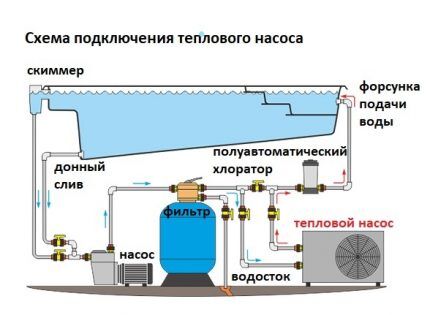
Main characteristics:
- power consumption - 1.6 kW;
- thermal power - 9 kW;
- water flow - 4000 l/h.
The pump heat exchanger is made of titanium. Special electrical and water connectors make installation easy. The device is equipped with a digital display.
Thermal unit #2 – Azuro
Azuro is a trademark of a Czech manufacturer. Specializes in the production of frame pools, equipment and accessories. Particularly popular are models made specifically for the garden.
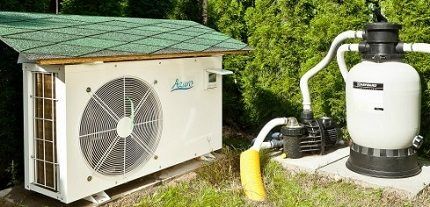
In order not to move the heat pump every time, it is installed under a canopy.
Main characteristics:
- power consumption - 1.7 kW;
- thermal power - 8.5 kW;
- pool volume - 20-30 m3.
The heat exchanger material is titanium. Digital display and built-in thermostat.There is an automatic evaporator defrost function. Easy installation.
Thermal unit #3 – Fairland
Fairland is a Chinese manufacturer founded in 1999. The company specializes in the design and production of thermal equipment. Successfully sells products in more than fifty countries.

Such a pump can be connected to the heating system of the dacha.
Main characteristics:
- power consumption - 1.7 kW;
- thermal power - 7.5 kW;
- water flow - 4000-6000 l/h.
Like previous models, the heat exchanger is made of titanium. Due to the use of inverter technology, it has extended operating conditions: from -7 degrees to +43 °C.
The device is equipped with a soft start to avoid power surges. All control occurs from the digital panel.
The development of technology every year makes the use of heat pumps more and more efficient. The average payback period for a heat pump is 4-5 years.
Counterflow pumps
With a special pump to create a countercurrent, you can swim in a small home pool. There are two types of counterflow pumps:
- Mounted. Suitable for small seasonal pools. These are units that have everything in one: pump, nozzles, lighting, handrails, automation and control. The advantage of this design is the ease of installation.
- Built-in. Equipped with a suction mechanism capable of extracting water above and below its level. They are distinguished by a more expensive and complex design. They are mainly used in the construction of stationary swimming pools.
When installing counterflows, you should pay attention to the water level: the level of the counterflow area should be 120-140 mm higher than the water level.
Counterflow #1 – Speck
The Speck company was founded in 1909 in Germany and specializes in the production of pumping equipment for liquid and gaseous media.
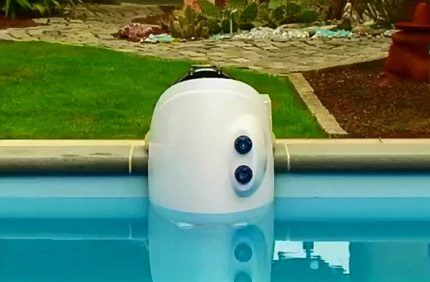
The model has excellent characteristics and a nice design.
Main characteristics:
- power consumption - 2.9 kW;
- productivity - 53 m3.
It is possible to connect special attachments for hydromassage to the device. Easy to install without damaging the walls of the pool. There is an adjustment for the amount of mixed air.
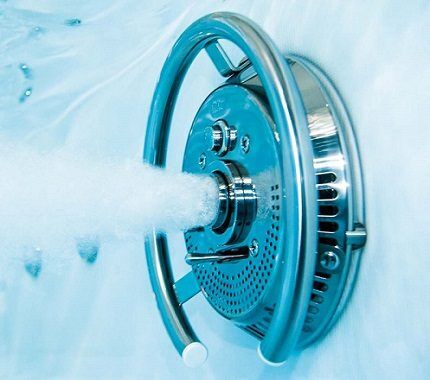
Main characteristics:
- power consumption: 3.3 kW;
- productivity: 58 m3.
Mounted counterflow units have increased power and are connected to a three-phase power supply. Designed for maximum loads for athletes. Has a built-in LED spotlight.
Counterflow #2 – Glong Electric
Glong Electric is a Chinese manufacturer of electric motors and water pumps. The company produces a wide range of pumps: from cheap plastic ones to expensive ones with a bronze body and high performance. The company was founded in the mid-90s.
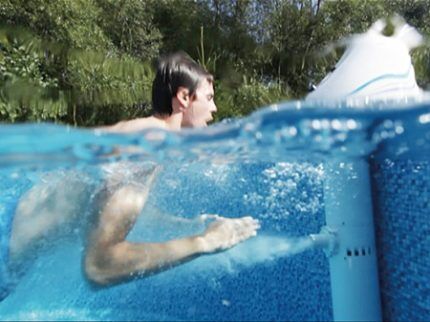
The model is easy to install and carry.
Main characteristics:
- power consumption: 2.9 kW;
- productivity: 54 m3.
A single-jet counterflow can serve as a hydromassage.To turn the device on and off, you don’t have to leave the pool; there is a special pneumatic button.
Countercurrent #3 – Pahlen
The Swedish company Pahlen was registered more than 40 years ago. Specializes in the production of equipment for swimming pools. Delivers to more than 70 countries around the world.

It can be equipped with an embedded part in the form of a handrail.
Main characteristics:
- power consumption - 2.2 kW;
- productivity - 54 m3.
Requires connection to a three-phase power supply. Made of bronze and stainless steel.
The delivery set includes a pneumatic start unit.
You may also be interested in how to correctly organize pool ventilation.
Conclusions and useful video on the topic
Review of sand pump modes:
Equipping a swimming pool with a counter-flow pump:
Operating principle and use of a heat pump:
Choosing a pump to service an artificial pond can be a very simple matter: just buy an all-in-one unit.
On the other side, a huge selection of pumping equipment makes it possible to realize any fantasy from a heated indoor pool to attractions and sports countercurrents.
Are you looking for a pool pump and can't decide on the right one? Or maybe you have experience using such equipment and would like to share it with our readers? Please leave your questions and valuable advice in the block below.
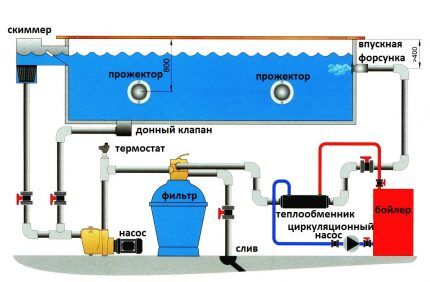




Let's take a closer look at modern swimming mattresses. Let's find out which models are designed for water, which ones you can sunbathe on, and which ones will help you throw a party in the pool.How to make a successful purchase without overpaying? Let's see how size, equipment, materials, design and prestige of the brand affect the cost.
I have personal experience using a filter from Intex. We used it to build a frame pool with a volume of about 6000 liters. In general terms, the model is good, but there are a couple of disadvantages that were not mentioned. Firstly, the plastic case is therefore quite fragile. Due to its white color, dirt accumulations are quickly visible on it (although this is not so important). Secondly, even with minor power failures, the filter may simply fail. Otherwise, everything works great - pumps water quickly, easy to clean, easy to use.
We've had a pool for 10 years now. Accordingly, the pumps were different. American, Chinese, even domestic. Everyone worked differently. The last one was the Czech Azuro. I worked for a couple of years. I died due to severe, abnormal frosts and my stupidity. It was necessary to insulate it somehow... Instead, they took the thermal French BWT PIONEER CPIR 21. By the way, there is no mention of this company at all in the article. They make good technology. So, returning to the Pioneer pump - it has been working for two years without any complaints. On the plus side, it is silent, can automatically adjust to the ambient temperature and change power accordingly, has a defrosting function, and even a 5-year warranty from the manufacturer, which also confirms the high level of quality.